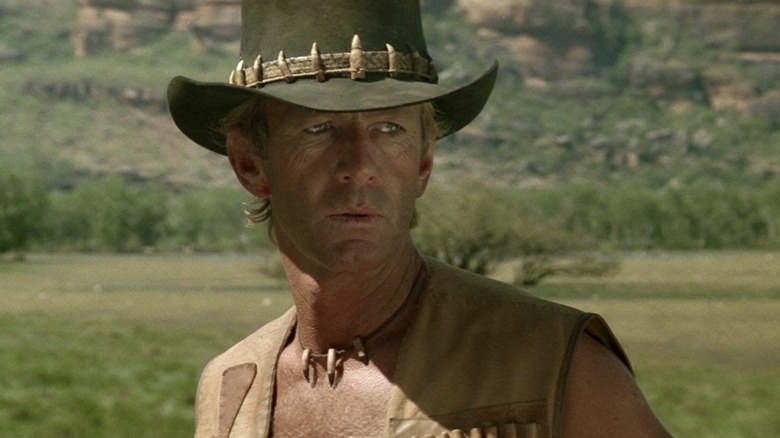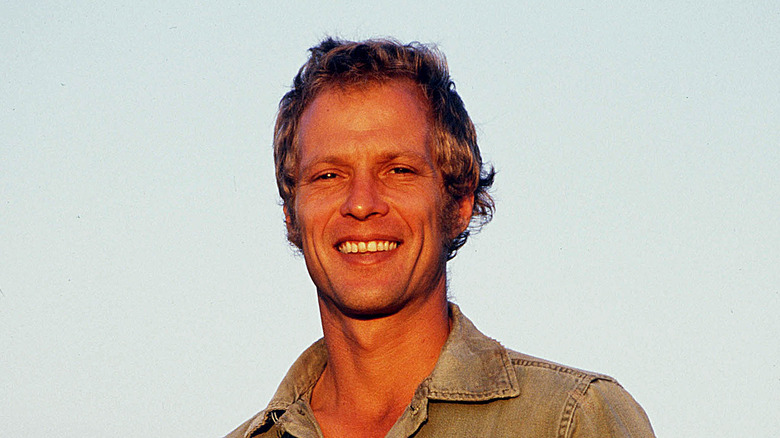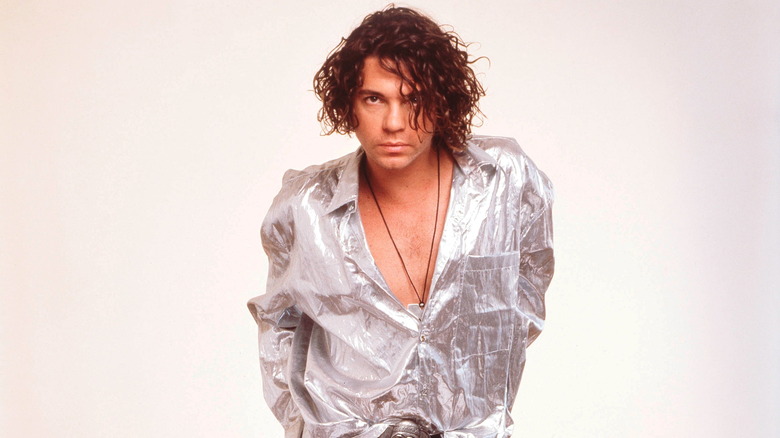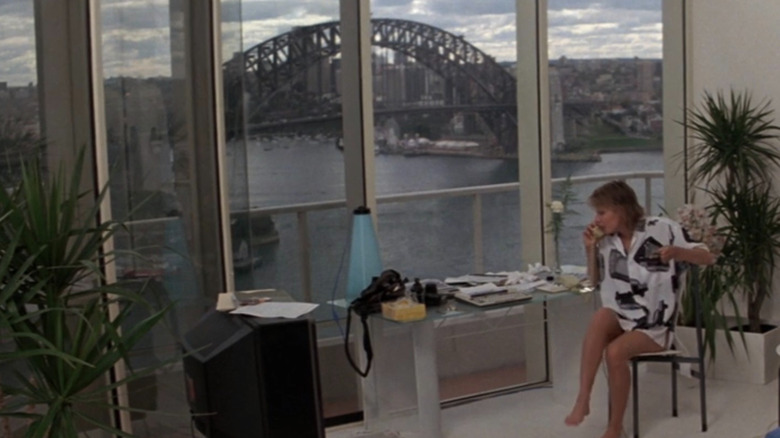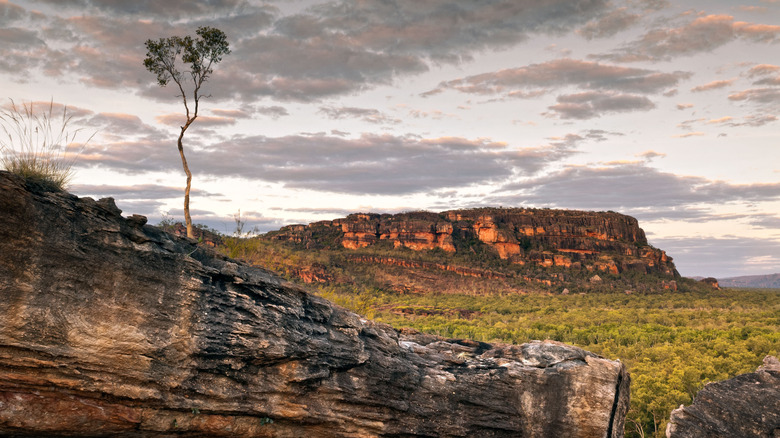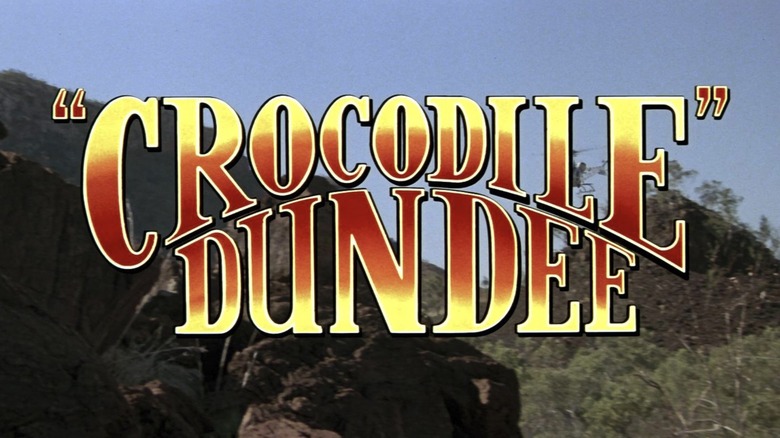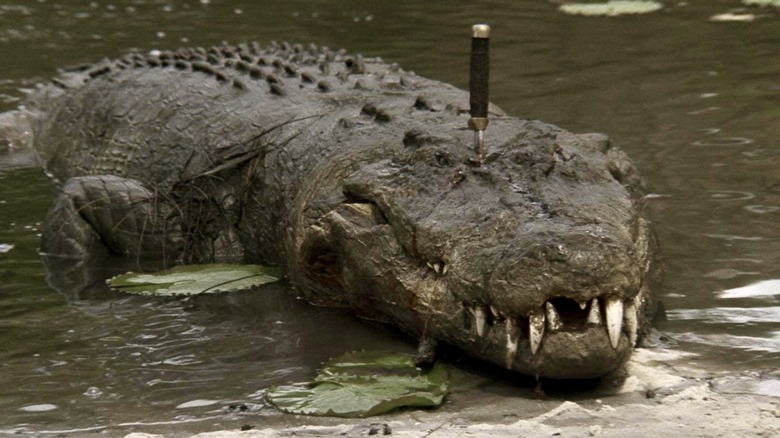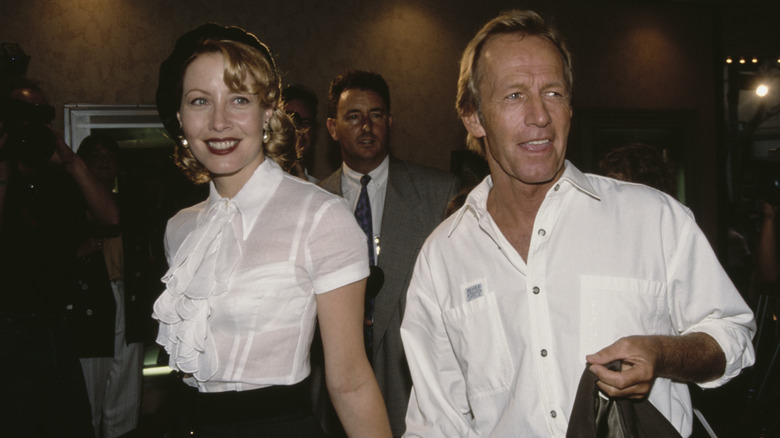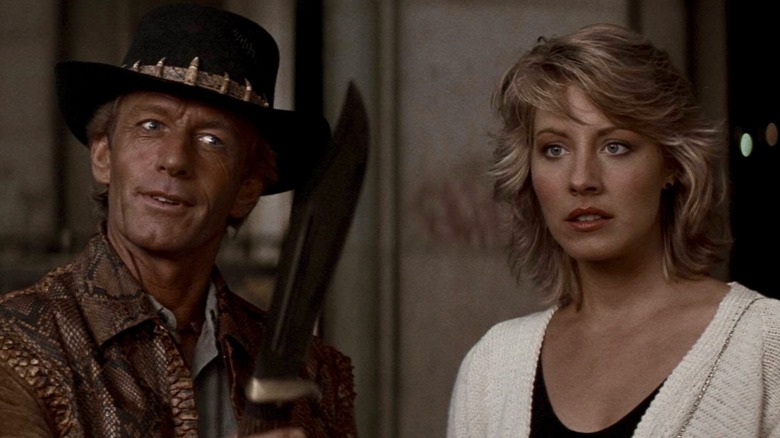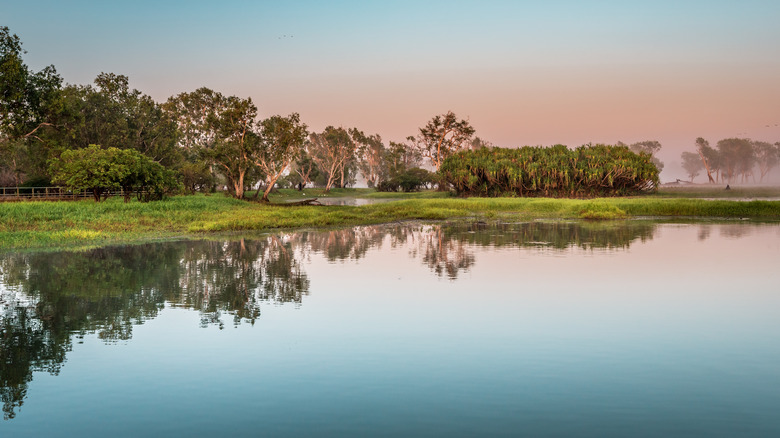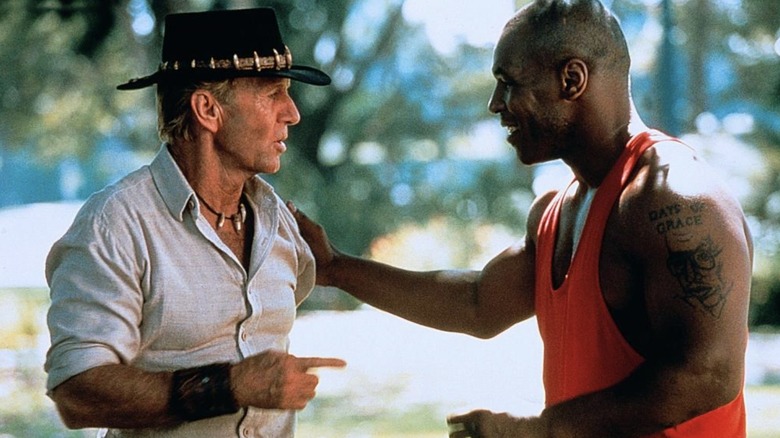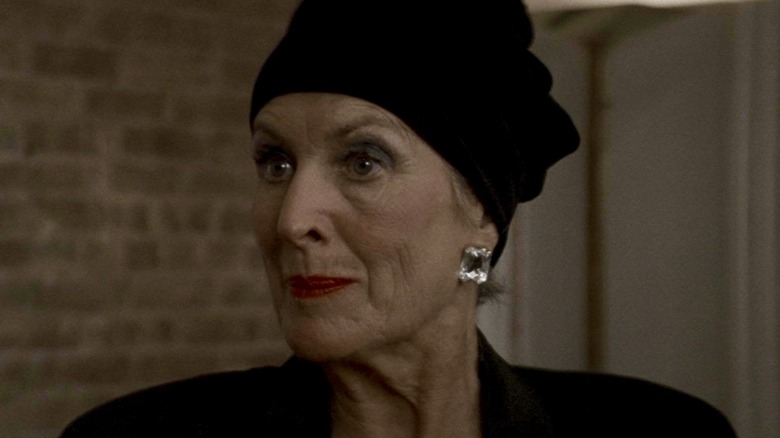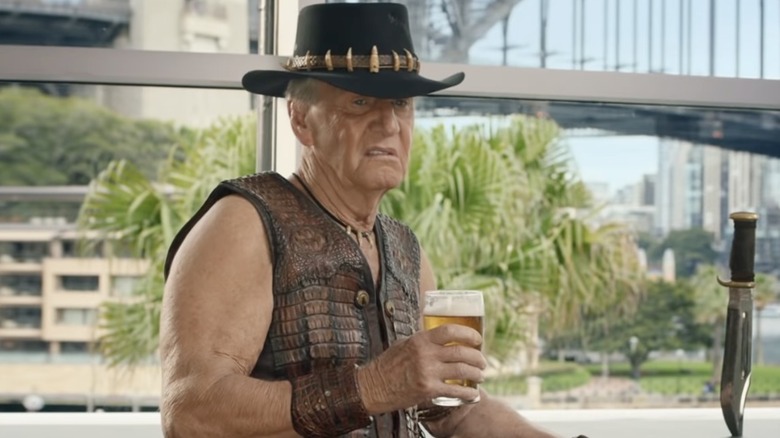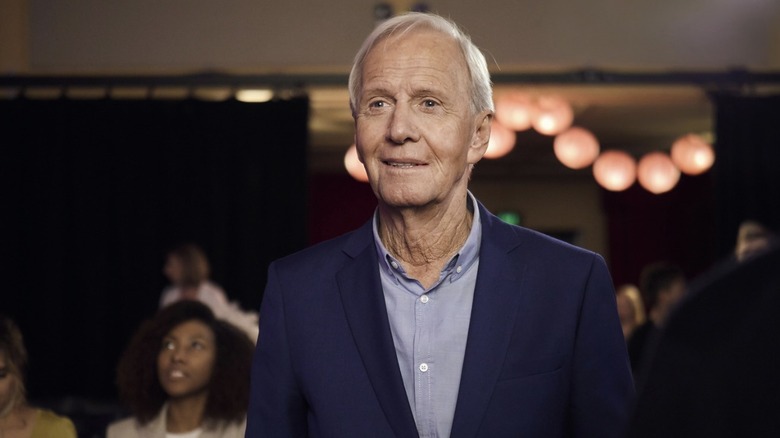13 Crocodile Dundee Facts That Come From A Land Down Under
You may have noticed movie stars are one of Australia's top exports to America. We've seen an influx of successful Aussies to Hollywood over the past 30 years, and Paul Hogan arguably paved the way when his independent comedy hit screens in 1986. "Crocodile Dundee" was a surprise hit when it invaded America and opened the U.S. market to more commercial cinematic imports from the land down under.
Mick "Crocodile" Dundee became an '80s icon, introducing the world to the local charm and natural beauty of Australia's rugged outback. Decades later, Mick Dundee is still intrinsically tied to Americans' perceptions of Australia. Although the series went downhill after the first movie, it achieved some surprising accomplishments, including garnering an Oscar nod for its script. Despite not being a holiday film, "Crocodile Dundee" has the bizarre distinction of having the largest television audience on Christmas day, which was achieved in 1989 in the UK.
Keep reading to learn 13 more surprising facts about the franchise from the land down under.
Rod Ansell's survival story may have inspired Crocodile Dundee
Paul Hogan told the BBC a trip to New York inspired his fish-out-of-water, tale, saying, "I felt like an alien from another planet, some of the 'Bushie' guys I know would feel even more out of place. There's a myth that there is a real Crocodile Dundee, but there isn't." Many believe Rod Ansell's 1977 survival story was the inspiration for the character Mick Dundee.
Per Independent Australia, Ansell became famous in Australia after surviving, with his two puppies, for seven weeks on limited supplies on an island after a massive crocodile capsized his boat in the Fitzmaurice River in the Northern Territory. Indigenous Aborigines saved Ansell, per The Independent. When people learned Ansell survived off the land, and even resorted to drinking buffalo blood, his unlikely survival story fascinated them. Michael Parkinson interviewed Ansell, and he told viewers he slept on the floor at the luxury hotel in Sydney, just like Mick Dundee later did in the movie.
Although Understanding Journalism says this interview inspired Hogan, there are no interviews where Hogan confirms the interview and survival story was an inspiration for the iconic character. In 1980, Ansell published his story in the book, "To Fight the Wild." According to Independent Australia, after "Crocodile Dundee" became a hit, Ansell became bitter because he never earned royalties from the film. Per the Herald Sun, in 1999 Ansel died in a drug-fueled shootout that left one officer dead, and other civilians injured.
The lead singer of INXS was one of the film's investors
Per The New York Times, the financing group that funded "Crocodile Dundee" was the brainchild of John Cornell, Paul Hogan's business partner, who envisioned an inventive model to finance the independent comedy. They actually choose to not partner with the Australian Film Commission because they wanted full creative control over the project. They eschewed large investors, instead gaining 1400 small investors through an interview in the Australian business magazine Rydges. The Queensland investment bank, Jarden Morgan Ltd. agreed to underwrite $7.1 million of the project. Hogan and Cornell reportedly invested $600,000, and Michael Hutchence, the lead singer of the Australian band INXS, was one of the many investors who helped bring "Crocodile Dundee" to the screen.
After they completed the film, Cornell flew to the U.S. to look for a distributor. Per The New York Times, Paramount snapped up the U.S. distribution rights of "Crocodile Dundee" after 20th Century Fox turned Cornell down after watching only 20 minutes of the movie. After the first and second "Crocodile Dundee" movies were huge commercial hits, Cornell told The New York Times the Fox executive "was extremely rude. I sometimes get pleasure from thinking about what the look is like on his face at a time like this."
Paul Hogan worked on the Sydney Harbour Bridge as a rigger
The first scene in "Crocodile Dundee" has a big Easter egg referencing Paul Hogan's life before acting. It happens when we see the Sydney Harbour Bridge in the background while Sue Charlton (Linda Kozlowski) talks to her editor/boyfriend on the phone at the beginning of the film. Per The Canberra Times, before Hogan became a sketch comic, he was a rigger who worked on the iconic bridge.
Hogan told The Canberra Times he got his start on "New Faces" which he called, a precursor to "Australian Idol" style talent shows. Hogan told IGN he did the contest on a dare and won over the audience by roasting the judges. Hogan explained that he never really wanted to be an actor and "didn't get into entertainment until I was like 31. I didn't star in a movie until I was 46." Per The New York Times, after appearing in the talent contest, Hogan was interviewed at the Sydney Harbour Bridge for the show, "A Current Affair."
Because of this interview, Hogan met John Cornell, who would later become Hogan's business partner. After doing comedic segments for the news show, Cornell and Hogan started JP Productions, and "The Paul Hogan Show" made Hogan famous in Australia, and later in the U.S. after the sketch series became syndicated internationally. Hogan then became the face of Australian tourism with an advertisement inviting Americans to visit "the wonders down under," setting the stage for the success of "Crocodile Dundee" in America.
The cast and crew slept in huts while filming in Australia
"Crocodile Dundee" was filmed on location in Australia and New York City. Per Travel + Leisure, production for the "outback" happened in the isolated Kakadu National Park in the Northern Territory, which had been home to a uranium mine. Craig Bolles, the Australian location scout for "Crocodile Dundee" selected the isolated region because "The location was terribly important for the film ... It showcased a part of Australia that I don't think had been seen ... and it was inherent in Paul's nature. He seemed to fit into the landscape perfectly."
Although Kakadu National Park has become a popular tourist destination, Bolles explained that "Kakadu was a very different place in the 1980s to what it is today. Only the main road was sealed (paved) and there were no hotel facilities at all as far as I can remember." Per Australian Film Tales, because they were so far from hotels, everyone on the cast and crew slept in huts left behind by the Pancontinental Mining Company. Despite the dilapidated condition of the camp, the cast and crew made the best of it, spending their nights around a campfire, creating a summer camp atmosphere.
The Australian and international versions were different
Per The New York Times, after test screenings with American audiences, Paramount made an international cut of "Crocodile Dundee." The international version of the film that American audiences saw in the theater was seven minutes shorter to speed up "the pace to the taste of the American consumer," Barry London, president of distribution at Paramount told The NY Times when the film hit theaters in 1986.
As reported by The NY Times, most of the cut screen time came from the first half of the film while Mick Dundee showed Sue Charlton around the Outback of Australia. During the test screenings, American audiences also struggled to understand the Australian slang in the film, so much of that was cut as well. Per Movie-Censorship, The f-word was cut from the film so it could have a PG rating in the U.S. Per The New York Times, Paramount also added quotation marks around "Crocodile" on the posters and the title card so everyone would understand it was a man's nickname, not a movie about a crocodile.
The crocodile that attacked Sue was animatronic
Per Australian Film Tales, Paul Hogan had planned on using a real crocodile for close-ups during the scene where Sue was attacked, but it wasn't in the cards and production purchased a mechanical crocodile for $45,000. Although the crocodile that attacks Sue while she's cooling off in the water was animatronic, there were real crocodiles all over the set and they hired an armed guard to protect the production from crocodile interference. A crocodile wrangler named Grahame Webb oversaw safety during production on set in Australia according to Perth Now.
In 2021 while promoting "The Very Excellent Mr. Dundee" Hogan told Go Erie that despite the attacking crocodile being fake, "there were real crocs in the water during filming," adding "We had guys up trees with rifles just in case one came along and ruined everything." Despite worrying about unruly crocodiles while making "Crocodile Dundee" Hogan told IGN that the water buffalo from the first film was the real stubborn diva on set, explaining the scene where he mesmerizes the buffalo took all day, "Cause if the buffalo doesn't want to do anything, it weighs 2000 pounds and you know, it doesn't."
Paul Hogan and Linda Kozlowski got married after meeting while filming
Per ET Canada, Paul Hogan met his first wife Noelene Edwards when they were teenagers at the swimming pool where he was a lifeguard, and they married young in 1958. Hogan told Australian Story, "I had three sons by the time I was 22, so I had to grow up very fast." As reported by ET Canada, Hogan, and Edwards separated briefly in 1981 but married again less than a year later.
Although Paul Hogan was actually still married to Noelene while making "Crocodile Dundee," he ultimately left his first wife in 1986 for his co-star. It was a very public divorce, with Australian media outlets reportedly depicting Hogan as abandoning his family. This development must have surprised Roger Ebert because his review of their movie specifically commented on their lack of chemistry, but obviously, Hogan and Kozlowski were feeling it.
Per the Los Angeles Times, Hogan married Kozlowski in 1990 in Australia during a private ceremony at a mansion he built as a wedding gift to his bride. They had a son named Chase and settled in Los Angeles, where they raised him together. Per The Sydney Morning Herald, Kozlowski filed for divorce in 2013, telling the paper, "Honestly, we just naturally grew apart." In 2014, their divorce was finalized and Hogan retained rights to "Crocodile Dundee" in the settlement. Kozlowski told New Idea (via The Sydney Morning Herald), "The divorce was completely amicable [...] Everybody's happy."
Crocodile Dundee was a huge commercial success
"Crocodile Dundee" hit Australian cinemas on April 24, 1986, and Hogan predicted it would be a commercial success, telling Cinema Papers "I expect it to gross millions of dollars around the world, and I'm planning for it to be Australia's first proper movie." Mick Dundee hit screens in the U.S. on September 26, and Hogan was right. It was one of the highest-grossing films of 1986, only being outdone at the U.S. box office by "Top Gun."
Hogan's debut feature film was a very successful independent small-budget film, raking in 37.3 times the production budget in world box office numbers. Per The Sydney Morning Herald, "Crocodile Dundee" remains the highest-grossing Australian film at the Australian box office to this day. Of course, having your first feature film become such a trouncing success certainly set Hogan up for high expectations.
In 2022 Hogan told Mark Meets, "because of the ridiculous success of Dundee, which is still the most successful independent film ever made, it's sort of like, 'Oh, whatever I do next will be a flop by comparison. So why bother?' So mentally I sort of retired after the first one." Although Hogan and Linda Kozlowski starred in the follow-up "Crocodile Dundee II," Hogan was right — it made a lot of money at the box office but didn't out-earn the original movie in the franchise — though it still made the top five at the box office in 1988.
The success of Crocodile Dundee changed tourism in Australia
U.S. audiences were already familiar with Paul Hogan before "Crocodile Dundee" came out because of the Australian tourism advertisements he donated his time during the '80s. When Hogan's first film became an international success, it altered tourism in Australia. In 2016, Peter Hook, communications manager at Kakadu Tourism, told Travel + Leisure, "In '86, Australians hadn't even been to Kakadu, let alone Americans. Basically, Kakadu was a mining area. Uranium was its biggest mineral. The government actually built a road from Darwin to Kakadu—not for tourism, but for mining." The film brought tourists, and the area became more accessible with the construction of improved roads.
In 2016, tourism chief executive Tony Mayell told Perth Now "The film helped put Australia on the map, let alone Kakadu," adding that "Crocodile Dundee" and Kakadu National Park still get an average of 135,000 Google searches monthly. Per The Guardian, they even started giving "Crocodile Dundee" tours in Kakadu National Park where the movie was filmed, and in Darwin, where you can have close encounters with live crocodiles. Three hours away in Jabiru, you can stay in the indigenous-owned Mercure Crocodile Hotel which is shaped like a crocodile, before exploring the wilderness of Kakadu through guided tours, scenic flights, or arts and craft lessons with indigenous Aborigines tribes who have lived in the Northern Territory for at least 40,000 years.
The third film in the series was nothing but a headache
There is no nice way to put this — "Crocodile Dundee in Los Angeles" is bad. So bad it was nominated for a Razzie for the worst sequel or remake in 2002 and was a flop at the box office. Paul Hogan and his wife Linda Kozlowski came out of retirement to make one last Dundee film, where they move with their son, Mikey (Serge Cockburn), from Walkabout Creek to Los Angeles so Sue can replace the LA division chief after his unexpected and suspicious death. They uncover an illegal operation fencing stolen artwork through a cut-rate film production studio and hijinks ensue.
According to Den of Geek, there was a dispute over the script between screenwriting duo Matthew Berry and Eric Abrams and Hogan. Hogan extensively rewrote their screenplay and believed he should receive the writing credit. Ultimately, the Writers Guild sided with the original scriptwriters, giving Berry and Abrams credit, despite Hogan appealing the decision to the Writer's Guild. Hogan's response to the dispute was negative, telling The Los Angeles Times, "Anyone who ever saw the first two movies will know who wrote whatever comes out of anyone's mouth, but because I didn't change the plot and I am the producer, I was not credited as a writer."
Some story elements haven't aged well
A writer for The Guardian called out "Crocodile Dundee" for story elements they called, "sexist, racist, homophobic, and transphobic" and they weren't wrong. Some dialogue and scenarios in all three films in the franchise haven't aged well and can easily be construed as offensive to women, people of color, and the LGTBQIA+ community. The most obvious is Sue not being depicted as a journalist in her own right, but working for her boyfriend on her father's paper.
There are transphobic moments in the first film when Mick gropes two trans women. There are also the offensive comparisons between indigenous Aboriginal tribes arguing for land rights in Australia to "fleas arguing over who owns the dog they live on," and Mick asking Sue Charlton's Black chauffeur, Gus (Reginald VelJohnson) what tribe he's from. In the second film, Mick is so shocked to be consoling a gay man, he nearly falls off a skyscraper, and in the third film Mick makes disparaging comments about a gay bar in Los Angeles.
While discussing cancel culture with The Project, Hogan said, "It's sometimes understandable, and in some cases, stupid. In the case of me and the shows I did, it was never designed to hurt anyone." Hogan told IGN the gay bar scene in Los Angeles was inspired by an experience he had with Olivia Newton-John at a bar. Per The Daily Mail, Hogan told The Australian, "I don't think I ever did anything with any sort of malice."
A 2018 Super Bowl tourism advertisement fooled millions
In January 2018, teasers began dropping on the internet, followed by a 2018 Super Bowl ad featuring Danny McBride, Chris Hemsworth, and Paul Hogan, and a full trailer. The advertisement fooled millions into briefly thinking "Crocodile Dundee" was getting a reboot. Soon after the Super Bowl, Insider revealed it was actually a $27 million dollar ad campaign to revitalize Australian tourism. McBride told Insider, "It wasn't like I was looking to do a Super Bowl commercial, but I just thought the concept of this was just too funny to see what people's reaction would be like."
Australia's Minister for Trade, Tourism, and Investment, Hon Steven Ciobo, told Tourism Australia, "This is the single largest investment Tourism Australia has ever made in the US market and one we believe will grow annual spend by American visitors to A$6 billion by the year 2020." The ad campaign had another result. According to Slate, some people wished the reboot was real. According to CBS News, some fans even signed a petition. The Daily Mail reported Hogan has no plans to make another "Crocodile Dundee" movie, telling Today, "It's not gonna happen."
Paul Hogan poked fun at himself in the satire The Very Excellent Mr. Dundee
In 2020, Paul Hogan starred in "The Very Excellent Mr. Dundee," a satire with Hogan playing a fictionalized version of himself. The movie depicts him getting into hot water on social media, leading up to being knighted by the Queen of England. Hogan told Boomer Magazine, "It's not a deep meaningful movie, just a bit of fun ... While it pokes fun at Hollywood rules and how social media through the modern online community can give you a reputation that you don't deserve, it's mostly aimed at me."
Hogan making himself the butt of the joke is certainly familiar ground for the Aussie whose self-deprecating humor won audiences back in the '70s and '80s. Although critics panned "The Very Excellent Mr. Dundee," giving it abysmal scores on Rotten Tomatoes, Hogan enjoyed poking fun at celebrity culture, which is something he knows a bit about after playing a character who is far more famous than he ever was.
In 2020 Hogan also released his memoir, "The Tap-Dancing Knife Thrower: My Life (without the boring bits)." Hogan told Go Erie his longtime writing partner Dean Murphy wrote the screenplay, saying, "It was Dean again who talked me into doing [the book], telling me that if I dictated it, he'd write it down, so that appealed to my lazy side." Hogan might be done with Hollywood, but that doesn't mean audiences have forgotten him, or that iconic role from the land down under.
